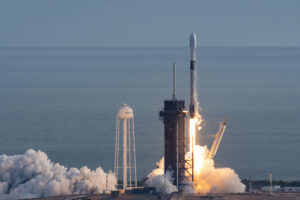WASHINGTON — The National Reconnaissance Office entrusts the U.S. Space Force to launch most of its spy satellites. But the NRO also is using other types of commercial contracts to send spacecraft to orbit, a practice that likely will continue, the agency said.
The NRO builds and operates the U.S. government’s spy satellites and for decades has been a major customer of the National Security Space Launch (NSSL) program run by the Space Force. The NRO helps fund technical support and mission assurance activities for NSSL.
That partnership will not change, NRO Director Christopher Scolese told lawmakers May 24. The agency however will procure services outside the NSSL program, for example, to launch missions on tight schedules or to to deploy lower-cost research payloads.
Scolese spoke during a hearing of the House Armed Services Committee’s subcommittee on strategic forces in response to a question from Rep. Doug Lamborn (R-Colo.). Lamborn asked why the NRO purchases launch services under “delivery in orbit” contracts.
These are contracts usually awarded to satellite manufacturers for the spacecraft and the launch service. Delivery-in-orbit launches are funded separately from the NSSL program and the contract awards are not made public.
Lamborn and other lawmakers have questioned intelligence agencies’ procurements of launch services outside the NSSL program, arguing that it makes NSSL missions more expensive.
The NRO in recent years has launched satellites on SpaceX and Rocket Lab rockets under commercial contracts.
An NRO spokesman said the agency is a partner of the Space Force in the NSSL program and also “uses a variety of methods to procure launch services in support of the overhead reconnaissance mission.”
There are several reasons for choosing alternative launch options, the spokesman said. The agency considers factors like satellite risk tolerance, required launch dates, available launch vehicles and cost. “All with a purpose of ensuring satellites are safely and securely delivered to orbit in a timely manner.”
Space industry analyst Andrew Penn, of the consulting firm Avascent, said the NRO is being smart about taking advantage of market efficiencies.
“That’s how launch should be procured,” he said of the NRO approach. Higher NSSL prices are justified for exquisite satellites where the government wants to minimize risks. “If a mission doesn’t require the same degree of mission assurance, why should they pay that extra markup?” said Penn.
Schedule is a key driver as well, he said. “If a mission requires an accelerated timeline, why should they have to wait in the NSSL line if other options exist? With more launch providers now available, the NRO can get payloads on orbit sooner.”
Penn said the Space Force’s launch enterprise has reasons to be concerned that the NRO is looking at other means to deploy its satellites.
The Space Force last year awarded five-year deals to United Launch Alliance and SpaceX to launch DoD and intelligence agency satellites. Both companies compete for individual missions on a yearly basis. When providers win commercial deals outside NSSL, they can offer more competitive pricing for NSSL missions. Even though the government benefits if providers offer lower prices, having fewer missions could make the NSSL program less efficient. However, Penn said, a handful of missions to date are unlikely to have a consequential effect.
Despite concerns from some lawmakers, Congress is unlikely to take any action to keep the NRO from making its own decisions, Penn noted.
“Relative to the U.S. Space Force, Congress historically has left the NRO to its own devices. It’s what makes the NRO as effective as it is. It’s not burdened by the same red tape as the Space Force,” he said.
The NRO’s approach to launching satellites is typical of the agency’s culture, Penn said. “Creativity is rewarded in the NRO. They have more autonomy, and incentives to take risks and do rapid acquisition.”
Col. Robert Bongiovi, head of the Space Force’s Space and Missile Systems Center launch enterprise, said NSSL Phase 2 was “constructed to provide affordable and innovative access to space.”As to why agencies pursue other options to launch their satellites, “you have to talk to those two agencies on why they chose different approaches,” Bongiovi said in November during a Mitchell Institute event.
– Advertisement –
